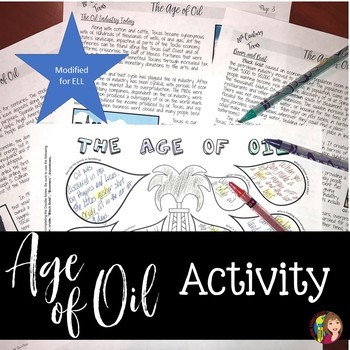Description
Engage your students with information on the Oil Industry in Texas with a variety of activities. Your students will play a game to learn vocabulary terms, read informational text and complete Doodle Notes, process their learning with a variety of activities.
This resource includes extra informational pages that have been modified for ELL or 4th grade students.
You’ll receive:
• 13 different Word Wall Images for the Oil Industry,
• a Vocabulary Game to introduce the key terms,
• Three pages of Informational Text on the Oil Industry in Texas including Spindletop, the boom and bust cycle, and the oil industry today. You will also receive modified pages of informational text indicated with a star.
• Multiple activities to process the information, including Sensory Figures, “Take a Selfie”, Just One, Blackout Poetry, and more!
Students of all ages will enjoy this activity – provide novelty to your older students with activities that engage all sides of the brain.
⭐Please download the preview to see more information on this resource.
⭐Doodle notes is a trademarked term used with permission. Please visit doodlenotes.org for more information.
2019 TEKS for 7th Grade Texas History
(1) History. The student understands traditional historical points of reference in Texas history through absolute and relative chronology . The student is expected to:
(A) identify the major eras in Texas history, describe their defining characteristics, and explain the purpose of dividing why historians divide the past into eras, including Age of Oil;
(C) explain the significance of the following dates: …1901, discovery of oil at Spindletop.
(7) History. The student understands how individuals, events, and issues shaped the history of Texas during the 20th and early 21st centuries. The student is expected to:
(A) explain the political, economic, and social impact of the oil industry on the industrialization of Texas;
(B) define and trace the impact of “boom-and-bust” cycles of leading Texas industries throughout the 20th and early 21st centuries such as farming, oil and gas production, cotton, ranching, real estate, banking, and computer technology;
(8) Geography. The student uses geographic tools to collect, analyze, and interpret data. The student is expected to:
(A) create and interpret thematic maps, graphs, charts, models, and databases representing various aspects of Texas during the 19th, 20th, and 21st centuries; and
(B) analyze and interpret geographic distributions and patterns in Texas during the 19th, 20th, and 21st centuries.
(9) Geography. The student understands the effects of the interaction between humans and the environment in Texas. The student is expected to:
(A) identify ways in which Texans have adapted to and modified the environment and explain analyze the positive and negative consequences of the modifications;
(11) Geography. The student understands the characteristics, distribution, and migration of population in Texas in the 19th, 20th, and 21st centuries. The student is expected to:
(B) analyze how immigration and migration to Texas in the 19th, 20th, and 21st centuries have influenced Texas;
(C) analyze the effects of the changing population distribution and growth in Texas during the 20th and 21st centuries and the additional need for education, health care, and transportation; and
(12) Economics. The student understands the factors that caused Texas to change from an agrarian to an urban society. The student is expected to:
(A) explain economic factors that led to the urbanization of Texas;
(B) trace the development of major industries that contributed to the urbanization of Texas such as transportation, oil and gas, and manufacturing; and
(C) explain the changes in the types of jobs and occupations that have resulted from the urbanization of Texas.
(13) Economics. The student understands the interdependence of the Texas economy with the United States and the world. The student is expected to:
(A) analyze the impact of national and international markets and events on the production of goods and services in Texas such as agriculture, oil and gas, and computer technology;
(B) analyze the impact of economic concepts within the free enterprise system such as supply and demand, profit, government regulation, and world competition on the economy of Texas; and
(C) analyze the impact of significant industries in Texas such as oil and gas, aerospace, medical, and computer technologies on local, national, and international markets.














Reviews
There are no reviews yet.